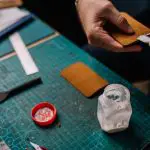Have you ever wondered if you could dye rayon fabric? Rayon is a popular choice for clothing and home decor due to its soft and breathable qualities, but many people are unsure if it can be successfully dyed. The good news is that rayon can be dyed, and with the right techniques and materials, you can achieve vibrant and long-lasting results.
Before you start the dyeing process, it’s important to understand the characteristics of rayon fabric. Rayon is a semi-synthetic fiber made from wood pulp, which gives it a unique texture and drape. However, this also means that it can be sensitive to heat and chemicals, so it’s important to choose the right dye and follow the proper preparation and application steps.
With a bit of patience and attention to detail, you can transform your rayon fabric into a custom-colored masterpiece.
Table of Contents
Understanding the Characteristics of Rayon Fabric
You’ll want to understand the characteristics of rayon fabric before attempting to dye it, as it behaves differently than other materials due to its cellulosic origins. Rayon is a man-made fabric that’s composed of regenerated cellulose fibers. It’s known for its soft and comfortable texture, as well as its ability to drape and flow beautifully. However, it’s also notorious for shrinking and stretching when wet, which can pose a challenge when dyeing.
Another characteristic of rayon fabric is its absorbency. Rayon is a highly absorbent material, which means it can take in a lot of dye. This can be both a good thing and a bad thing. On one hand, it allows for vibrant and rich colors to be achieved. On the other hand, it can also result in uneven coloring or bleeding if not dyed properly.
Therefore, it’s important to be aware of the dye concentration and to use appropriate dyeing techniques when working with rayon fabric.
Lastly, rayon fabric is sensitive to heat and chemicals, which can affect its color and texture. High temperatures can cause the fibers to break down, resulting in a loss of color and a weakened fabric. Chemicals such as bleach or acid can also damage the fibers, causing discoloration or even holes.
When dyeing rayon, it’s important to use gentle and safe dyeing methods, such as low-heat immersion dyeing or natural dyeing techniques. By understanding these characteristics of rayon fabric, you can ensure successful and beautiful results when dyeing it.
Choosing the Right Dye for Rayon
If you’re planning to dye your rayon fabric, it’s important to choose the right type of dye. There are three main types of dyes that are suitable for rayon: fiber reactive dyes, acid dyes, and natural dyes.
Each type has its own unique characteristics and advantages, so it’s important to consider your specific needs and preferences when choosing a dye for your project.
Fiber Reactive Dyes
Using fiber reactive dyes on your rayon fabric will give you vibrant and long-lasting colors that won’t fade or wash out easily. These dyes are specially formulated to bond with the cellulose fibers in rayon, creating a permanent color that remains bright and vivid, even after multiple washings. If you want to achieve the best results when dyeing your rayon fabric, fiber reactive dyes are definitely the way to go.
Here are some reasons why fiber reactive dyes are a great choice for dyeing rayon fabric:
- They produce vibrant colors that won’t fade or wash out easily.
- They’re easy to use and can be applied using a variety of techniques, including hand dyeing, tie-dyeing, and immersion dyeing.
- They’re compatible with a wide range of fabrics, including rayon, cotton, silk, and linen.
- They’re available in a wide range of colors, so you can choose the perfect shade for your project.
Acid Dyes
Get ready to add a pop of color to your wardrobe with acid dyes! These dyes are perfect for rayon fabric, as they work by bonding with the protein fibers of the fabric. This means that not only do they produce vibrant colors, but they also create a strong and long-lasting bond with the fabric, ensuring that your dye job will stay bright and beautiful for years to come.
When using acid dyes on rayon fabric, it’s important to keep in mind that the dyeing process can be a bit more complicated than with other types of dyes. You’ll need to use a mordant, such as vinegar or citric acid, to prepare the fabric for dyeing and ensure that the color sets properly.
You’ll also need to take care to follow the instructions carefully and avoid using too much dye, as this can lead to uneven color distribution and splotchy patches. But with a little bit of patience and attention to detail, you’ll be able to create stunning, colorful pieces that are sure to turn heads!
Natural Dyes
Let’s dive into the world of natural dyes and discover the beautiful and sustainable hues they can add to your wardrobe. Rayon, being a cellulose-based fabric, is an excellent candidate for natural dyeing. With a variety of plant-based materials available, you can easily experiment with different colors and achieve unique results.
Here’s a table that lists some commonly used natural materials and the colors they produce when used to dye rayon fabric:
| Natural Material | Color Produced |
|---|---|
| Onion skins | Yellow to orange |
| Madder root | Red to brown |
| Indigo | Blue |
| Turmeric | Yellow |
| Black walnut hulls | Brown to black |
With natural dyes, you can achieve a wide range of colors, from vibrant yellows to deep blues. It’s worth noting that natural dyes tend to be more subtle and muted compared to synthetic dyes, but they also come with a unique charm and character. Plus, they’re sustainable and eco-friendly, making them an excellent choice for those looking to reduce their environmental impact. So, go ahead and experiment with natural dyes on your rayon fabric, and discover the beauty of sustainable fashion.
Preparing the Rayon Fabric for Dyeing
Before dyeing your rayon fabric, it’s important to properly prepare it. Start by washing and drying the fabric to remove any dirt or debris that may be present.
Then, pre-treat the fabric with a fixative to help the dye adhere better and prevent fading.
By following these steps, you can ensure that your rayon fabric is ready for dyeing and that the color will last for a long time.
Washing and Drying
When washing and drying rayon fabric, you should be gentle and avoid using high heat to prevent shrinking or damaging the fibers. Rayon is a delicate fabric that requires extra care when laundering to maintain its softness and draping qualities. Here are some tips on how to properly wash and dry rayon fabric:
| Do’s | Don’ts | Tips |
|---|---|---|
| Hand wash or machine wash on a gentle cycle | Do not use high heat | Use a mild detergent |
| Use lukewarm water | Do not wring or twist the fabric | Air dry or use a low heat setting |
| Gently squeeze out excess water | Do not bleach or use fabric softeners | Iron on a low setting, if needed |
| Lay flat or hang to dry | Do not tumble dry | Handle with care |
By following these simple guidelines, you can ensure that your rayon fabric stays in great condition. Proper washing and drying techniques not only prevent damage to the fabric but also help to preserve its color and texture. Remember to always read the care label on your rayon garment and follow the manufacturer’s instructions for best results.
Pre-treating with Fixative
To ensure optimal results, it’s important to pre-treat your rayon garment with fixative before dyeing. This will help the fabric hold onto the dye and prevent it from fading or bleeding. Here are three easy steps to follow when pre-treating with fixative:
-
Mix the fixative with water according to the package instructions.
-
Soak your rayon garment in the fixative solution for at least 20 minutes.
-
Rinse the garment thoroughly with cold water and then wring out any excess moisture before proceeding with dyeing.
By pre-treating your rayon fabric with fixative, you’ll be setting the stage for a successful dyeing process. Not only will it help the dye adhere better, but it will also ensure that the color stays vibrant and doesn’t fade over time. So, take the extra step and pre-treat your rayon garment before dyeing to achieve the best results possible!
Applying the Dye to Rayon Fabric
Now it’s time to apply the dye to your rayon fabric!
There are three main techniques you can use: immersion dyeing, hand painting, and tie-dyeing.
With immersion dyeing, you’ll submerge your fabric in a dye bath.
Hand painting allows you to create more detailed designs, while tie-dyeing offers a fun and unique look with its signature swirls and patterns.
Immersion Dyeing
Immersion dyeing is a fantastic technique for transforming plain rayon fabric into a colorful masterpiece that will leave you feeling ecstatic. This method involves completely submerging the fabric into a dye bath and allowing it to soak until the desired level of color intensity is achieved. It’s important to note that the longer the fabric remains in the dye bath, the deeper the color will be.
To successfully immersion dye your rayon fabric, you’ll need to prepare a dye bath by adding your chosen dye to hot water in a large pot or container. Then, immerse the fabric into the dye bath and stir it continuously to ensure that the color is evenly distributed. You can play around with different dyeing techniques such as ombre, tie-dye, or dip-dye to create unique and interesting patterns.
Once you’re satisfied with the color, remove the fabric from the dye bath and rinse it thoroughly with cold water until the water runs clear. Finally, hang the fabric to dry and enjoy your beautifully dyed rayon fabric.
Hand Painting
Hand painting allows for a more precise and controlled approach to adding color to your fabric, as you can use brushes to create intricate designs and patterns. This method of dyeing is perfect if you want to create a unique piece of clothing or fabric that stands out from the rest.
Here are three reasons why you should consider hand painting your rayon fabric:
-
It gives you creative freedom: With hand painting, you can create any design or pattern you want, making your fabric truly one-of-a-kind. You can experiment with different colors and techniques to create something that reflects your personal style.
-
It’s cost-effective: Unlike other dyeing methods that require expensive equipment or large quantities of dye, hand painting only requires a few basic supplies like brushes, fabric dye, and water. This makes it an affordable option for those who want to experiment with dyeing their own fabrics.
-
It’s easy to do at home: Hand painting doesn’t require any special equipment or a lot of space, making it easy to do at home. All you need is a clean workspace and some creativity to get started. So why not try hand painting your rayon fabric and see what unique designs you can come up with?
Tie-dyeing
Get ready to add some color and excitement to your wardrobe with tie-dye! This fun and easy technique is a great way to give your rayon fabric a bold and unique look. Whether you’re a seasoned tie-dye pro or a newbie looking to try something new, you can create a range of patterns and effects with this method.
To get started, you’ll need to gather your materials. This includes your rayon fabric, dye, rubber bands, gloves, and a large bucket or container. Once you’ve gathered your materials, it’s time to get creative!
You can try a classic spiral pattern, or experiment with different folding techniques for a one-of-a-kind look. Just remember to follow the dye instructions carefully, and to rinse your fabric thoroughly before wearing.
With a little bit of practice and experimentation, you’ll be a tie-dye pro in no time!
Finishing the Dyeing Process
After the fabric has been thoroughly rinsed and spun dry, it’s important to carefully examine the dyed rayon to ensure that all areas have been evenly colored. If you notice any areas that appear lighter or have not absorbed the dye, you can reapply the dye using a small brush or dropper. Be sure to blend the dye into the surrounding areas to achieve a uniform color.
Next, you’ll need to set the dye to prevent it from fading or bleeding. Fill a large pot with enough water to cover the fabric and add a cup of white vinegar. Bring the water to a boil and add the dyed rayon. Let the fabric simmer for at least 30 minutes, stirring occasionally.
Turn off the heat and let the fabric cool in the pot. Rinse the fabric again in cold water to remove any excess dye and vinegar.
Hang the fabric to dry in a well-ventilated area away from direct sunlight. Avoid using a dryer as the heat can cause the fabric to shrink or damage the dye. Once the fabric is completely dry, you can iron it on a low heat setting to remove any wrinkles.
With these steps, you can successfully dye rayon fabric and enjoy your new colorful creation.
Tips and Tricks for Achieving Vibrant and Long-lasting Results
If you want to achieve vibrant and long-lasting results when dyeing rayon fabric, there are a few tips and tricks you should keep in mind.
First, try mixing colors to create your desired shade.
Second, consider creating patterns to add visual interest to your fabric.
Finally, don’t be afraid to experiment with different dyeing techniques to achieve unique and beautiful results.
By following these tips, you can create stunning and long-lasting dyed rayon fabric.
Mixing Colors
Let’s dive into how we can mix colors to create the perfect shade on our rayon fabric! Mixing colors can be a fun and creative process, but it can also be a bit tricky. The key is to start with the right colors and to mix them in the right proportions. Here is a handy chart to help you get started:
| Color 1 | Color 2 | Resulting Color |
|---|---|---|
| Red | Yellow | Orange |
| Blue | Yellow | Green |
| Red | Blue | Purple |
| Red | White | Pink |
As you can see from the chart, mixing primary colors can create secondary colors. However, it’s important to remember that the resulting color will depend on the proportions of each color that you use. For example, mixing more red than blue will result in a more reddish purple, while mixing more blue than red will result in a more bluish purple.
Once you have a basic understanding of color mixing, you can experiment with different combinations to create the perfect shade for your rayon fabric. Don’t be afraid to play around with different proportions and shades until you find the perfect match. With a bit of practice, you’ll be able to create vibrant and long-lasting results on your rayon fabric.
Creating Patterns
So you’ve learned about mixing colors when dyeing rayon fabric, but what about creating patterns? That’s right, you can also play with different patterns to give your rayon fabric a unique and eye-catching look.
Here are some ways you can create patterns when dyeing rayon fabric:
- Tie-dyeing: This classic technique involves tying parts of the fabric with rubber bands or strings before dyeing it, creating a beautiful and intricate pattern.
- Shibori: Similar to tie-dyeing, Shibori involves folding and twisting the fabric before dyeing it to create unique patterns.
- Dip-dyeing: This technique involves dipping only certain parts of the fabric into the dye, creating a gradient effect.
- Stencil dyeing: Using stencils, you can create precise patterns and designs on your rayon fabric.
- Resist dyeing: Using wax or other resist materials, you can create patterns by preventing certain areas of the fabric from absorbing the dye, creating a unique and intricate pattern.
By experimenting with different dyeing techniques and patterns, you can transform your rayon fabric into a one-of-a-kind piece that’s truly your own. So why not try out these techniques and see what kind of beautiful patterns you can create?
Experimenting with Different Techniques
Get ready to unleash your creativity and take your DIY projects to the next level by experimenting with a variety of techniques to create unique and stunning patterns on your rayon fabric.
Rayon is a versatile fabric that can be dyed using a variety of techniques, such as tie-dye, dip-dye, shibori, and batik. Each technique creates a different effect, and the possibilities are endless.
Tie-dye is a classic technique that involves tying the fabric with rubber bands or string before immersing it in dye. Dip-dye involves dipping the fabric in dye at different depths to create an ombre effect. Shibori is a Japanese technique that involves folding, twisting, and binding the fabric before dyeing it to create intricate patterns. Batik is a technique that uses wax to create a resist before dyeing the fabric.
Experiment with these techniques and see what patterns and colors you can create on your rayon fabric.
Caring for Your Dyed Rayon Fabric
When it comes to caring for your dyed rayon fabric, you need to be careful. Avoid using hot water and high heat when washing and drying, as this can cause the color to fade and the fabric to shrink.
Additionally, it’s important to avoid exposing your dyed rayon fabric to direct sunlight and heat. This can also cause the color to fade and the fabric to become brittle.
Finally, make sure to store your dyed rayon fabric properly. Hang it or fold it neatly in a cool, dry place to prevent any wrinkles or damage.
Washing and Drying
After dyeing rayon fabric, it’s important to wash and dry it properly to ensure the color stays vibrant and the fabric stays in good condition. Here are some tips to help you care for your dyed rayon fabric:
-
Use cold water. Rayon is a delicate fabric and hot water can cause it to shrink or lose its shape. Use cold water to rinse and wash your dyed rayon fabric.
-
Use a mild detergent. Harsh detergents can damage rayon fabric, causing it to fade or lose its softness. Use a mild detergent when washing your dyed rayon fabric to keep it looking and feeling like new.
-
Avoid wringing or twisting. Rayon fabric can easily become misshapen when it is wrung or twisted. Instead, gently squeeze the excess water out of your dyed rayon fabric and lay it flat to dry.
-
Hang or lay flat to dry. When drying your dyed rayon fabric, avoid using a dryer. The heat can cause the fabric to shrink or lose its shape. Instead, hang or lay your fabric flat to dry in a shaded area.
Avoiding Sunlight and Heat
Don’t let all your hard work go to waste – protect your vibrant new creation by keeping it out of direct sunlight and away from heat sources. Rayon is a delicate fabric that can easily fade and lose its color if exposed to the sun and heat. To maintain the vibrancy of your newly dyed rayon fabric, it’s important to follow some simple precautions.
Firstly, avoid leaving your rayon in direct sunlight for prolonged periods of time. The UV rays from the sun can cause the dye to fade and the fabric to weaken over time. Secondly, keep your rayon away from heat sources such as radiators, ovens, and fireplaces. The heat can cause the fabric to shrink and distort, ruining the shape and fit of your garment. By taking these simple steps, you can ensure that your newly dyed rayon fabric stays vibrant and beautiful for years to come.
| Do’s | Don’ts |
|---|---|
| Do store your dyed rayon fabric in a cool, dry place away from sunlight. | Don’t leave your dyed rayon fabric in direct sunlight for prolonged periods of time. |
| Do wash your dyed rayon fabric in cold water with a gentle detergent. | Don’t use hot water or harsh chemicals when washing rayon fabric. |
| Do iron your dyed rayon fabric on a low temperature with a pressing cloth. | Don’t use high heat when ironing rayon fabric as it can cause damage. |
| Do handle your dyed rayon fabric with care to avoid snags and tears. | Don’t use a dryer to dry rayon fabric as it can cause shrinkage and damage. |
Storing Properly
To ensure your beautiful rayon creation lasts for years to come, it’s crucial to store it properly, keeping it safe from any potential damage.
First, make sure your rayon garment is completely dry before storing it away. Any moisture left in the fabric can lead to mold and mildew, which can permanently damage the fabric.
Hang your rayon clothing on a hanger or fold it neatly and place it in a drawer or on a shelf. If you decide to hang it, make sure to use a padded hanger to prevent any stretching or distortion.
When storing your rayon clothing, it’s important to keep it away from direct sunlight and sources of heat. Exposure to sunlight and heat can cause the fabric to fade and weaken, leading to discoloration and damage.
Additionally, keep your rayon clothing away from any harsh chemicals or perfumes that can cause staining or discoloration. To protect your rayon garment even further, consider placing it in a garment bag or wrapping it in acid-free tissue paper.
By storing your rayon clothing properly, you can ensure that it stays in great condition for years to come.
- How to Sew With Suede and Faux Suede Fabric - July 12, 2025
- Is Suede a Good Fabric for a Sofa? Pros and Cons - July 12, 2025
- Using Fabric Paint on Suede: A How-To Guide - July 12, 2025






